Private First Class James Walter Williams
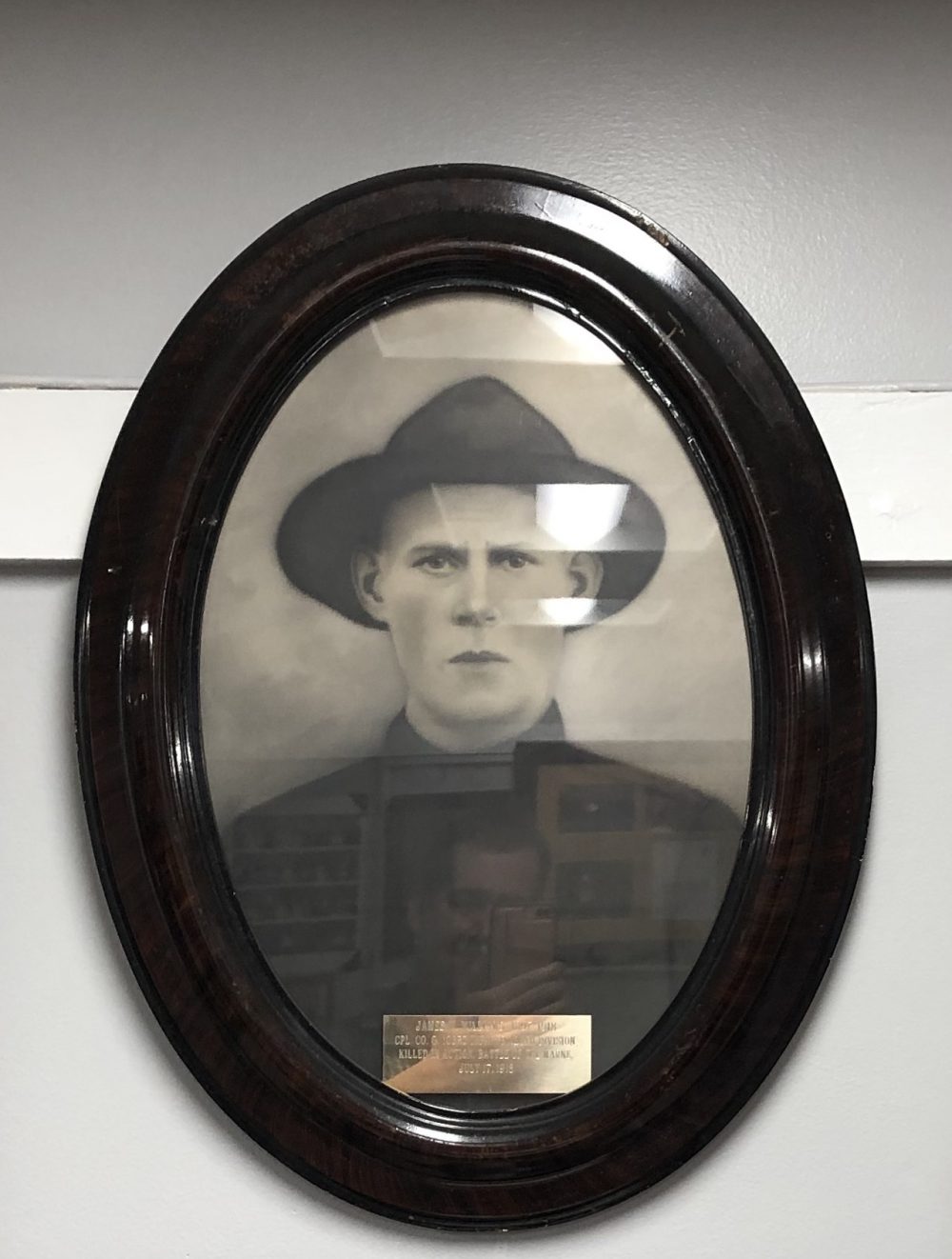
- Unit: 26th Infantry Division, 103rd Infantry Regiment, Company G
- Date of Birth: March 29, 1896
- Entered the Military: May 19, 1916
- Date of Death: June 17, 1918
- Hometown: Bangor, Maine
- Place of Death: near Belleau, France
- Cemetery: Plot A, Row 1, Grave 77. Aisne-Marne American Cemetery, Belleau, France
James F. Doughty School
2018-2019
Early Life
On April 29, 1896, James W. Williams was born in Fitts Bay, Quebec, Canada. Three months before his birth, James lost his father. Three weeks after his birth, his mother gave him up, sending him to live with her own father. James’ grandfather became his foster father. They moved to the notorious Hancock Street in Bangor, Maine. This street was part of the “Devil’s Half Acre,” also known as “Hell’s Half Acre,” or more simply, “The Acre.”
This area, close to the railroad lines and shipping ports, was a place where loggers, sailors and other laborers gathered to partake in any number of illegal activities. Williams himself was most likely caught up in some of this illegal activity because when asked on his National Guard Application if he had “ever been convicted of a felony or imprisoned under sentence of a court in a reformatory, jail, or penitentiary?” he wrote, “state reform school.”
At age 21, Williams worked as a laborer, spending summers as a longshoreman and winters as a logger. On June 19, 1916 he became a soldier. It was on this day that Williams walked into the National Guard office in Bangor and filled out the recruiting paperwork. At 5’6.25” tall and 144 pounds he was listed in good health, with 20/20 vision, and a sound intellect. He was ready to serve his country as part of the 2nd Maine.
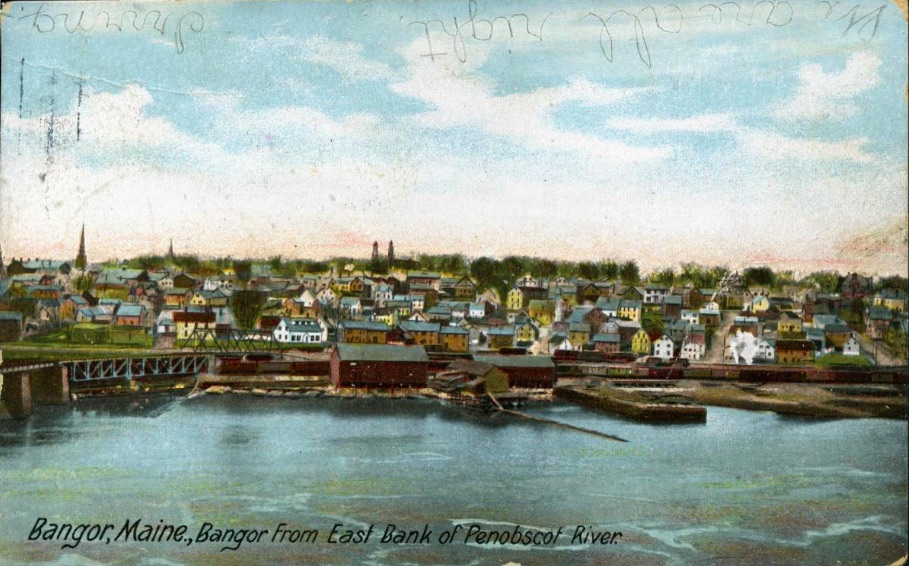
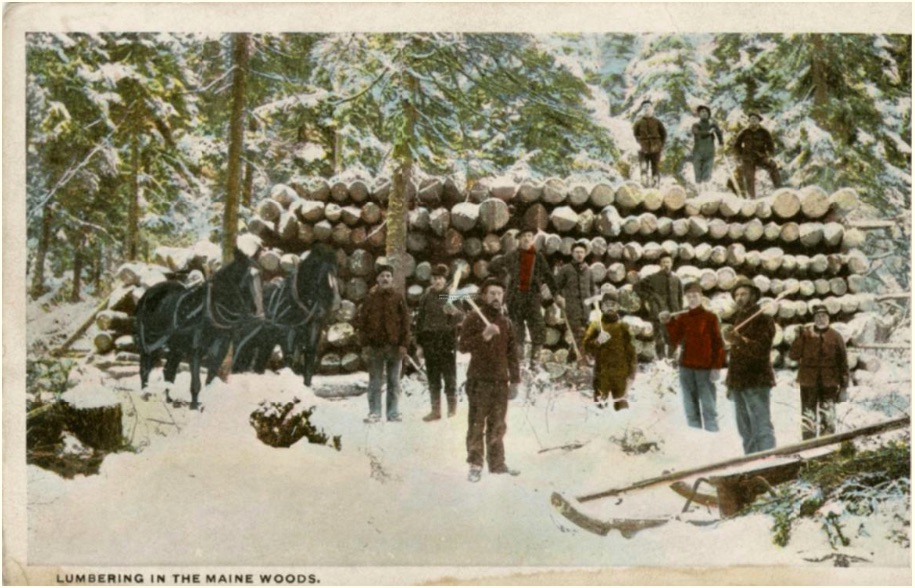
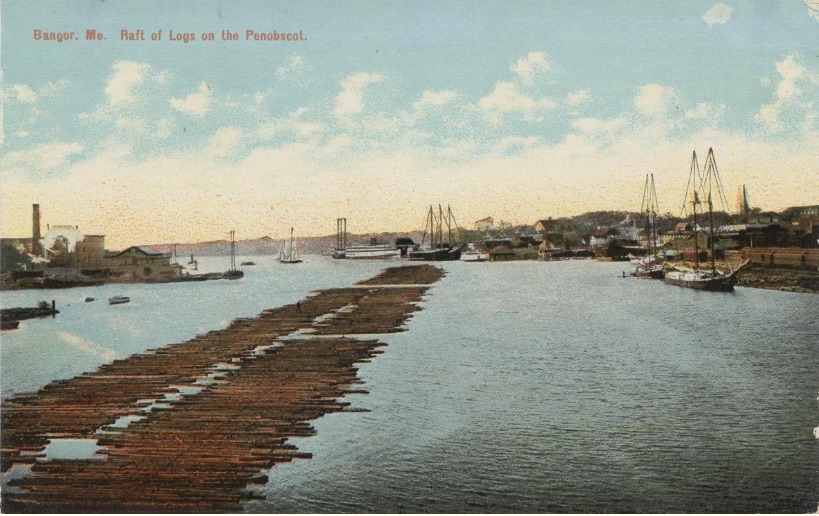
Military Experience
The U.S. Army sent the 2nd Maine to the Mexican border as part of what was referred to at the time as the Punitive Expedition. Over 158,000 National Guard troops patrolled the border of Mexico to guard against attacks by the infamous Pancho Villa, who had led a series of raids over a number of months attacking American citizens. While these patrols were ultimately unsuccessful, the soldiers received invaluable military training while working on the border.
In October the men returned to Augusta, Maine, the state’s capital. On November 25, 1916, the Army mustered out the men and sent them home. The United States entered World War I on April 2, 1917. Ten days later, the government recalled the unit into service. On April 13, the Army designated the 2nd Maine as the 103rd Infantry Regiment in the 26th Division. The regiment, known as the Yankee Division, included many members from New England.
Early in July, the regiment assembled in Camp Keyes in Augusta, Maine. Training continued until the men departed for Westfield, Massachusetts on August 19. Soldiers busied themselves with training as well as playing football and baseball during spare hours to keep up their spirits.
On September 24, the Army started to send units of the 26th Division “over there.” Great care was taken to keep the specific locations secret. Williams traveled aboard the R.M.S. Saxonia, and a convoy of ships gathered together in Halifax, Nova Scotia, Canada for the nine day journey. On-board, the soldiers drilled each day. On October 9, Williams and the 103rd Infantry Regiment arrived safely in Liverpool, England, before being sent over to France. The 26th Division became the first division of the National Guard to be organized, equipped, and sent overseas.
French officers trained the men intensely in trench warfare until January 1918. The training lasted six hours a day, five days a week. Saturday mornings the U.S. Army held inspections. However, on Saturday afternoons and Sundays the men enjoyed rest and recreation.
The regiment received orders to enter active combat on February 5 and 6, 1918. Williams and his battalion fought on the front lines near Bruyères, France for 11 days. The regiment then went back to the reserve line at Vregny before returning to the front lines of Pinon Forest at the start of March. The men completed their first rotation by the middle of March. The rotation had lasted longer than anyone had expected and the men expressed great joy at its conclusion. Even though this front was quiet and the casualties minimal, the men needed a rest. They returned to Liffol-le-Grand for a brief rest, and on April 1 orders came for their next move to the area around Belleau, France.
In late April, the German infantry raided sectors of the 26th Division. These were among the first attacks on American troops. On July 5, the 26th Division entered Belleau Wood to relieve the Marines of the 2nd Division. They endured two weeks of combat as they struck back in the opening moves of the Aisne-Marne offensive. The night before they were set to go “over-the-top,” Williams was in a shell hole with two other men, preparing for the attack. A shell landed directly in the hole and killed all of the men. Records later showed that Williams’s head had been shattered and both his upper and lower jaw were missing.
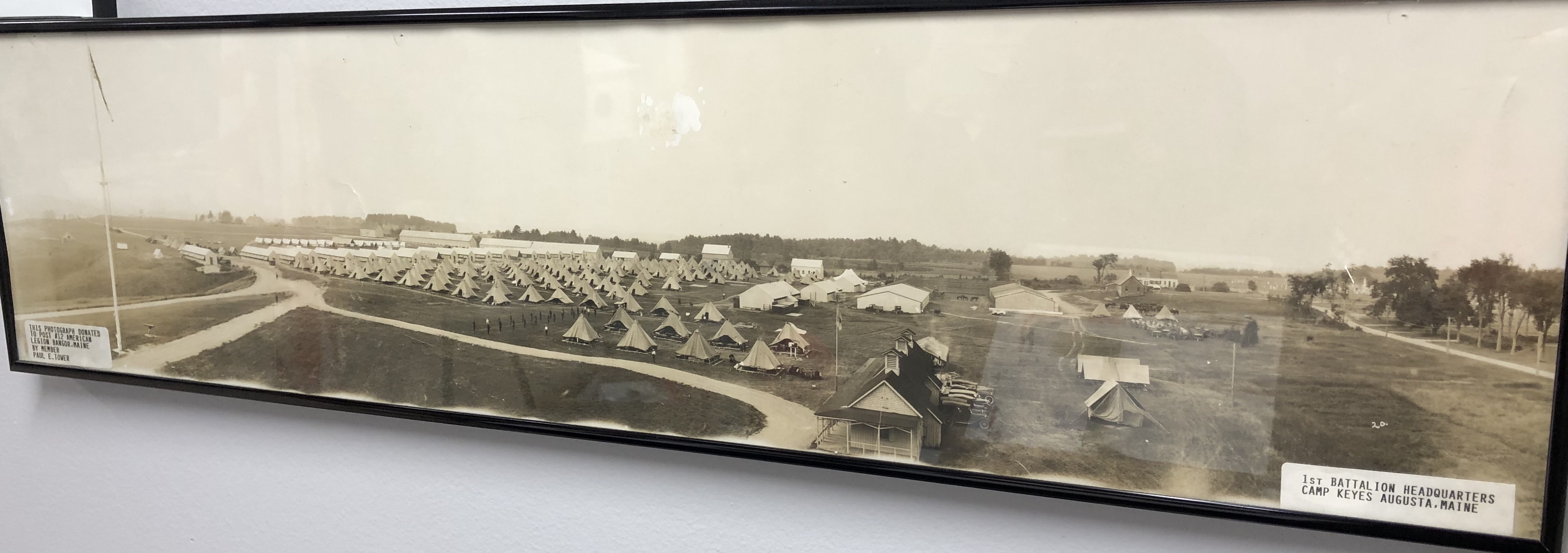
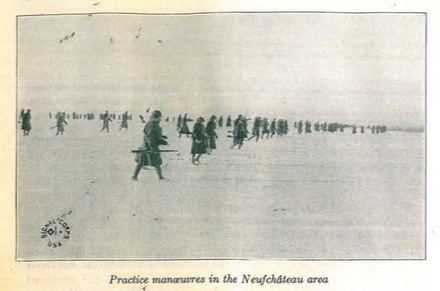
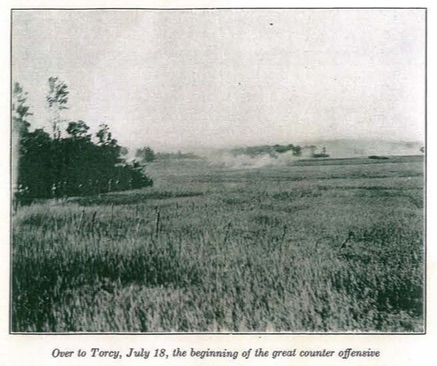
Eulogy
After Williams’s death, his grandfather requested that his body be returned to Maine for burial. Within months, he changed his mind and asked for Williams to be buried in France. Williams had been supporting his grandfather since he was 15 and had named his grandfather as beneficiary on his life insurance. There was some confusion as to his identity as he is listed as George Williams, George I. Williams, and Isaac Williams in legal documents.
Additionally, Isaac Williams, suffering from failing health, spent many months trying to prove that he had adopted James when he was an infant in order to collect his grandson’s backpay. Even though the documents burned in the Great Bangor Fire of 1911, his grandfather was granted the benefits. He lived off this income until his death. They then were passed on to James’ half-sister, Lillian.
The newly formed American Legion Post in Bangor was named after Williams on August 10, 1920, and the city dedicated a playground in his honor in 1939. In 2017, the legion conducted more research on his life and created a dedication marker at the park. The marker reads,
“James W. Williams Playground, Dedicated July 5, 1939; In Memory of a Brave Soldier. Private First Class James Walter Williams, Co. G, 103rd Infantry, 26th Div. (Yankee Division), KIA 7/17/18. 2d Battle of Marne. Buried Aisne-Marne American Cemetery, Grave 77, Plot A, Row 1, Belleau, France. James grew up as a foster child on Hancock Street and played on this field while attending a Catholic School operated here by the Sisters of Mercy.”
.jpg)
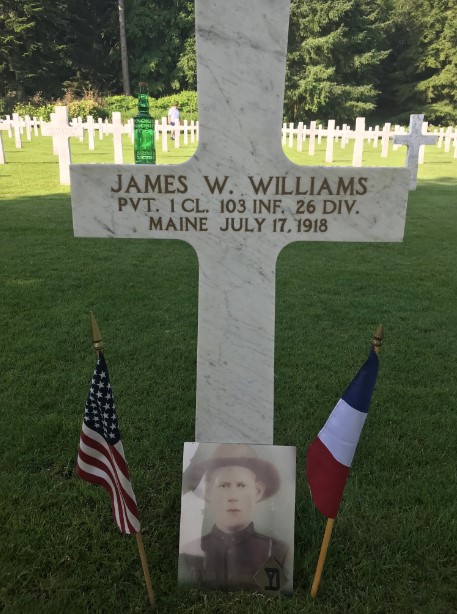
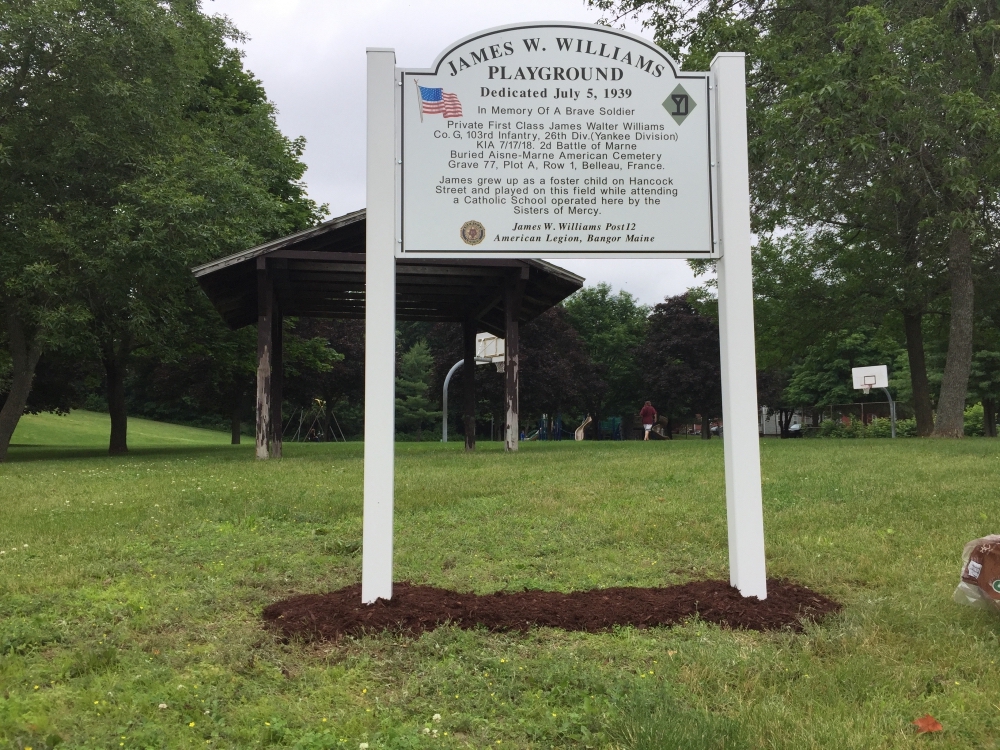
Reflection
Bibliography
26th Division; Records of Combat Divisions, 1918-1919, Records of the American Expeditionary Forces (World War I), Record Group 120 (Box 46); National Archives at College Park, College Park, MD.
26th Division; Records of Combat Divisions, 1918-1919, Records of the American Expeditionary Forces (World War I), Record Group 120 (Box 55); National Archives at College Park, College Park, MD.
26th Division; Records of Combat Divisions, 1918-1919, Records of the American Expeditionary Forces (World War I), Record Group 120 (Box 57); National Archives at College Park, College Park, MD.
103rd – 104th Infantry Regiments; World War I Strength Returns, Records of the Adjutant General’s Office, Record Group 407 (Box 43); National Archives at College Park, College Park, MD.
“The 103rd Infantry Regiment.” Soldiers’ Mail. Updated March 5, 2017. Accessed January 26, 2019. worldwar1letters.wordpress.com/the-adventure-unfolds/watchful-waiting-1917/26th-yankee-division/the-103rd-infantry-regiment/.
C. T. American Art. Bangor Lumber Company lumbermen. Photograph. c. 1910. Maine Memory Network (99452), Bangor Public Library. Image. www.mainememory.net/artifact/99452.
“History of the 26th Yankee Division.” Lane Memorial Library. Accessed January 26, 2019. www.hampton.lib.nh.us/hampton/history/military/26thDivisionYD/26thDivisionHistory1919.htm.
The Hugh C. Leighton Company. Bangor from the east bank of the Penobscot River. Postcard. c. 1905. Maine Memory Network (31562), Bangor Public Library. Image. www.mainememory.net/artifact/31562.
Ibid. Penobscot River lumber raft at Bangor. Postcard. c. 1905. Maine Memory Network (99450), Bangor Public Library. Image. www.mainememory.net/artifact/99450.
“James W. Williams.” American Battle Monuments Commission. Accessed August 25, 2019. abmc.gov/node/320994.
“James W. Williams.” American Soldiers of World War I. ancestry.com.
“James W. Williams.” Maine Military Index 1917-1920. ancestry.com.
“James W Williams Casualty. World War I. Maine.” Honor States. Accessed January 26, 2019. www.honorstates.org/index.php?id=139837.
James W. Williams World War I Burial Case File and Deceased Veterans Claim File (XC-28,201); Correspondence, Reports, Telegrams, Applications and Other Papers relating to Burials of Service Personnel, Records of the Quartermaster General’s Office, 1915-1935, Record Group 92; National Archives and Records Administration – St. Louis.
LeBlanc, Mark D. and John M. From Maine to France and Somehow Back Again.: World War I Experiences of John M. Longley and the 26th Yankee Division. Morrisville: Lulu Publishing Services, 2018.
Liles, Private J. E. Military cemetery showing the French, American, and German graves. Hdqtrs. 26th Div. Sommedieu, France. Photograph. September 2, 1918. National Archives and Records Administration (111-SC-23431-ac). Image.
National Museum of the United States Army. “An Unlikely War Poet: A Doughboy from Maine.” The Campaign for the National Museum of the United States Army. July 16, 2018. Accessed January 26, 2019. armyhistory.org/an-unlikely-war-poet-a-doughboy-from-maine/.
“Order of Battle of the US Army – WWII – ETO26th INFANTRY DIVISION.” 26th INFANTRY DIVISION – Order of Battle of the United States Army – WWII – ETO | U.S. Army Center of Military History, U.S. Army Center of Military History, history.army.mil/documents/ETO-OB/26ID-ETO.htm.
“Record of Deaths in World War I.” Maine State Archives (324817). Updated 2017. Accessed August 25, 2019. digitalmaine.com/wwI_personnel/1.
Reilly, Wayne E. “Where Was the Devil’s Half Acre?” Bangor Daily News, September 16, 2012. bangordailynews.com/2012/09/16/living/where-was-the-devils-half-acre/.
War Diaries (26th Division); A. E. F. General Headquarters, Records of the American Expeditionary Forces (World War I), Record Group 120 (Box 2684); National Archives at College Park, College Park, MD.
Welcome Home YD. Boston: Committee of Welcome Pamphlet, 1919.

